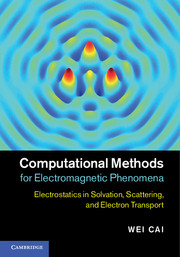 Computational Methods for Electromagnetic Phenomena
Computational Methods for Electromagnetic Phenomena Book contents
- Frontmatter
- Contents
- Foreword
- Preface
- Part I Electrostatics in solvation
- Part II Electromagnetic scattering
- Part III Electron transport
- 12 Quantum electron transport in semiconductors
- 13 Non-equilibrium Green's function (NEGF) methods for transport
- 14 Numerical methods for Wigner quantum transport
- 15 Hydrodynamic electron transport and finite difference methods
- 16 Transport models in plasma media and numerical methods
- References
- Index
16 - Transport models in plasma media and numerical methods
from Part III - Electron transport
Published online by Cambridge University Press: 05 February 2013
- Frontmatter
- Contents
- Foreword
- Preface
- Part I Electrostatics in solvation
- Part II Electromagnetic scattering
- Part III Electron transport
- 12 Quantum electron transport in semiconductors
- 13 Non-equilibrium Green's function (NEGF) methods for transport
- 14 Numerical methods for Wigner quantum transport
- 15 Hydrodynamic electron transport and finite difference methods
- 16 Transport models in plasma media and numerical methods
- References
- Index
Summary
In this, the final chapter of the book, we study the transport phenomena in plasma due to electrons and ions. These phenomena have wide applications in astrophysics, confined nuclear thermal reactions, and in high-density laser plasma interactions, etc. Plasma, considered as the fourth state of matter in the universe, differs from solids, liquids, and gases, in that there is a much weakened bond strength between its constituent particles. The plasma state of a medium is created via high-temperature external heating, which results in an increase in both the thermal energy and the number of atomic ionizations (i.e., an electron in an outer shell of an atom escapes from its nuclear force confinement once it obtains enough external energy from photon excitation or collision), which produces free-moving electrons and ions. The primary force in a plasma medium is described by the long-range Coulomb forces of electrostatics. The motions of the electrons and the ions can be described by a kinetic theory with special treatment of the collision under the long-range electric potential, which includes the Boltzmann– Fokker–Planck equations or the Balescu–Lenard equations. A macroscopic description of the electron/ion density can also be obtained through the moments of the kinetic equation as the magneto-hydrodynamic (MHD) equations. Three types of numerical methods based on kinetic and hydrodynamic models will be discussed in this chapter. The first type is the Boltzmann–Fokker–Planck solver in phase space, and the second is the particle-in-cell method, which tracks the dynamics of individual particles under the Lorentz force of the electromagnetic fields; the latter is also coupled to the charge distributions of the moving particles. Finally, the third type is a constrained transport method of finite difference type for the MHD equations, which observes the divergence-free constraint on the magnetic field.
- Type
- Chapter
- Information
- Computational Methods for Electromagnetic PhenomenaElectrostatics in Solvation, Scattering, and Electron Transport, pp. 402 - 418Publisher: Cambridge University PressPrint publication year: 2013


